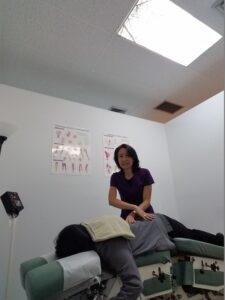
From Dr. Natalie Meiri’s Clinical Pearl Stories:
Chiropractor West Palm Beach: Restless Leg Syndrome
Author: Natalie Meiri, D.C. Posted: 10/27/24
This is my clinical pearl story about Chiropractor West Palm Beach: Restless Leg Syndrome. I helped this patient with more than his neck and back pain. His chief complaints were neck and back pain, leg movements during sleep and even involuntary leg movements when awake. He was a 42 year old male patient. To be HIPAA compliant, I will call him Francisco instead of his real name.
Francisco’s neck and back pain had come and gone over the years without any treatment. Then a month ago the restless leg syndrome had started. He had tried over the counter natural supplementation (e.g. magnesium), massage and even gone to a neurologist who ordered a MRI of his brain and ordered blood tests which all showed normal findings. The neurologist told him he had rest leg syndrome and gave him a prescription drug to help with the symptoms. Francisco didn’t like the side effects of nausea, dizziness and worsening sleep problems.
Francisco’s boat repair business was doing well, but it was a lot of hard manual labor which caused him stress. Additionally, he had a wife and they enjoyed hiking and camping together. Warren exercised regularly and “ate a healthy diet”. In fact, he had never been to a doctor since he was a kid until recently. However, both Francisco and his wife were having trouble sleeping lately because of his restless leg syndrome. So his wife suggested he see a chiropractor.
What is Restless Leg Syndrome (RLS)?
RLS is a form of sleep disorder that includes periodic limb movements in sleep (PLMS). It is a condition where involuntary motor movements of the limbs occur during the sleep cycle. Furthermore, this can lead to a shift in the sleep phases/stage and repeated awakenings. Temporary relief happens when the patient moves his/her legs.
If you cannot stop moving your legs or often have jerks, this could be restless legs syndrome or myoclonic jerks. These prevent and interrupt sleep. Restless Leg Syndrome is characterized by an irresistible urge to move the legs because of what’s been described as a “creeping” sensation inside the calves. Similarly, you may also have nocturnal myoclonus (sudden, brief involuntary twitching or jerking of a muscle).
Patients with restless leg syndrome may have an underlying cause which is a neurological and non-neurological disorder such as peripheral neuropathy, Parkinson’s disease, uremia, iron deficiency, varicose veins, rheumatoid arthritis, and side effects from certain medications. Moreover, it may be due to pregnancy. Also, there is a genetic/ inherited component believed to be related to a defect in dopamine (neurotransmitter that affects emotions, behavior, and movement) or iron metabolism.
The criteria for diagnosis of restless leg syndrome are the following: the desire to move the extremities, often associated with paresthesia (pins and needles) or dysesthesia (unpleasant abnormal sensation), motor restlessness, aggravation of symptoms by rest and at least temporary relief by activity, and worsening of symptoms in the evening or night.
1 in 10 people in the United States may have RLS. And the numbers may be higher due to misdiagnoses or underdiagnoses. RLS seems to be more prevalent in adults and advancing age. It is a major cause of insomnia.

Francisco’s Examination and Imaging
Upon examination, Francisco tested positive for his neuromusculoskeletal neck and back pain (cervicalgia and lumbago) conditions. And his history and imaging report from his neurologist confirmed his diagnose of RLS.
Alternative Treatments for Restless Leg Syndrome (RLS)
Firstly, if the RLS is due to a deficiency such as iron, supplementation is necessary. Vitamins and minerals like vitamin C, E, B6, and B12, magnesium, and iron may give relief. Eating a healthy diet as well as taking supplements is helpful.
Secondly, limiting caffeine, tobacco, and alcohol use may improve your RLS symptoms.
Thirdly, activities that provide mental stimulation and/or de stress your mind may also provide relief. In addition, Studies have shown a higher prevalence of RLS in persons who were sedentary and overweight. A moderate exercise regimen (e.g. 3-day per week exercise program) consisting of lower body resistance training and aerobic exercise may help significantly.
Fourthly, chiropractic care is an excellent natural alternative treatment for RLS without the side effects of drugs. Chiropractic “Manual procedures and, specifically, the adjustment are applied to address local NMS (neuromusculoskeletal) disorders and to improve NMS function. A consequence of improved NMS function may be improvement in the body’s ability to self-regulate, thereby allowing the body to seek homeostasis and improved health”.(1)
Simply put, spinal adjustments take pressure off your nervous system and help your body to function optimally. Adjustments help your body seek homeostasis, which is the state of steady internal, physical, and chemical conditions maintained for optimal survival and wellness.

Francisco’s Treatment and Outcome
First, Francisco’s treatments included chiropractic adjustment/ manipulation to his cervical (neck) and lumbar (low back) spine and associated regions. Associated regions were his thoracic (mid back) spine. And because of the restless leg syndrome, chiropractic manipulation was performed bilaterally (both) on his lower extremities (legs) as needed. Second, soft tissue therapy (myofascial release, pressure point and various post isometric relaxation procedures) was rendered as necessary. Third, modalities (cold/heat therapy and electric muscle stimulation) were administered as needed. Fourth, exercises for stretching, strengthening, and better posture were recommended.
Fifth, I recommended avoidance of alcohol, caffeine, and taking a multi-vitamin which included iron. Francisco stopped eating all sugary snacks, practiced proper fluid (water) and diet (fruits, vegetables, fiber) intake more vigorously.
Finally, after a few months of regular chiropractic care, Francisco’s neck/back pain and RLS improved and then subsided.
Are you looking for the best chiropractor in West Palm Beach? Dr. Natalie Meiri can definitely help you. Find out more about Chiropractor West Palm Beach: Restless Leg Syndrome. Call 561-253-8984 today for an appointment.
References:
Thomas Bergman, David Peterson, Chiropractic Technique Principles and Procedures, 3rd edition, 2011 (1)